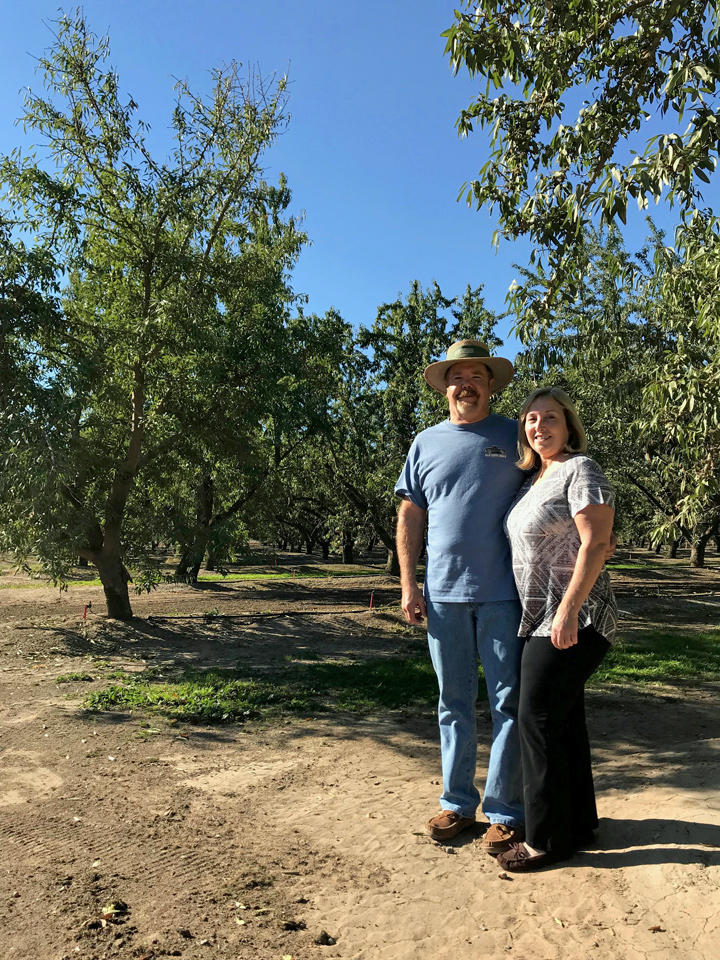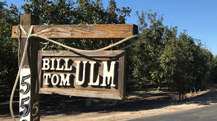Living and working on a conserved farm
This guest column was prepared by Melanee Cottrill, Associate Director, Central Valley Farmland Trust (CVFT). CVFT works with landowners and conservation partners to preserve agricultural lands in the California Central Valley for future generations.
“I haven’t been anyplace that I enjoy more than here.”
There is nothing but humble honesty in grower Tom Ulm’s voice, nothing but sincerity in his eyes, as he shares his adoration for the family farm that five generations of Ulms have called home.
Tom’s grandfather purchased the property outside Modesto in 1943. Back then, the farm was a dairy that Tom worked on growing up. Since then, the farm has morphed from grapes and corn, to almonds and grapes, to almonds and walnuts; from one family farm, to two; from brothers, to uncles and nephews, to cousins. The farm’s rich history is proudly detailed on posters and in photographs lining a stairwell in the Ulm family home. Throughout the years, one element has never wavered: Tom’s dedication to preserving the farming lifestyle.
Tom recalls his early days of being a farm advocate with a modest chuckle. When he was mayor for a day at his high school, Tom’s platform consisted of a simple, resonant statement: “No more growth!” Later, when Tom learned he could protect the family farm from city growth with an easement, he encouraged his father to pursue this route. Much to Tom’s dismay, his father, Bill, wasn’t convinced. That is, until a friend of Bill’s placed an easement on his nearby farm– then, said Tom, “all of a sudden it’s a good idea!”
In 2011, that good idea became an agricultural conservation easement protecting the Ulm’s 151 acres of prime farmland. Tom and his wife Irene rest easy knowing that the family farm is safe, regardless of whose hands it is in.
“We would definitely recommend [an easement] if you’re living in an area like we are,” said Irene. The Ulms want to “keep town as far away as we can,” Tom adds, “because right now the possibility is that it will reach our driveway.”
Tom and Irene are hopeful that more of their neighbors will move to permanently protect their farms. “We’ve had friends that have sold to development; we’ve seen what it does to them,” said Tom. He also noted, “Money doesn’t do anybody any good – as long as we have enough to survive.” Before placing an easement, they advise their fellow farmers to “look far down the road.”
“If you want to keep it there for your kids and grandkids,” protecting the farm with an easement is “the ideal thing to do,” said Tom.
When asked whether the easement protecting his farm has impacted how he farms, a typically talkative Tom struggled to find an answer. “We’re farming anyway,” he said, “so it hasn’t.” He is almost amused by our annual visits to ensure the farm is still a farm, in compliance with the protective easement. To this man, whose idea of a good vacation is avoiding snakes at an Australian almond conference, doing anything other than farming his land is practically inconceivable.
Over the years, Tom’s crops, and the technology he uses to grow them, have evolved. He fondly points out that an old tractor, once featured in a newspaper photo accompanying an  article on the family, is now enjoying its retirement next to the relatively new barn. Constructed of repurposed shipping containers, the barn is itself an innovation, as is the equipment it holds. After fifteen years of monitoring water conditions with digital in-ground probes, last year the Ulms moved to using a pressure chamber to sense moisture in leaves. Getting a more direct picture of the trees’ state has allowed Tom to be more strategic in his watering practices.
article on the family, is now enjoying its retirement next to the relatively new barn. Constructed of repurposed shipping containers, the barn is itself an innovation, as is the equipment it holds. After fifteen years of monitoring water conditions with digital in-ground probes, last year the Ulms moved to using a pressure chamber to sense moisture in leaves. Getting a more direct picture of the trees’ state has allowed Tom to be more strategic in his watering practices.
Today, Tom is happy to be on the land he loves, with the family he loves, doing a job he loves. “It’s a world all its own,” he said. “Living out here is not like the rest of the world.” And he wouldn’t have it any other way.
The decision to protect your land with a conservation easement is significant. It will impact (forever) future generation’s use of the land. For more information, contact the Central Valley Farmland Trust at (916) 687-3178 or visit ValleyFarmLand.org.


